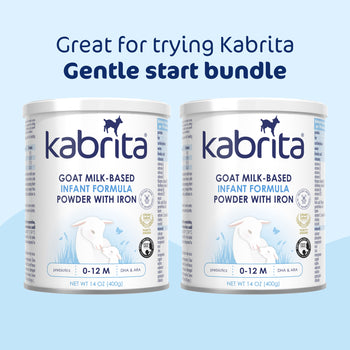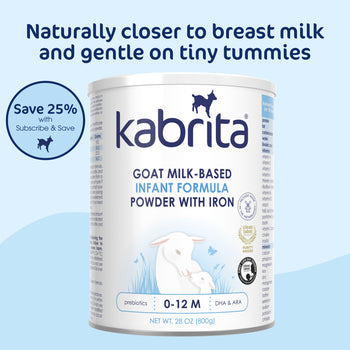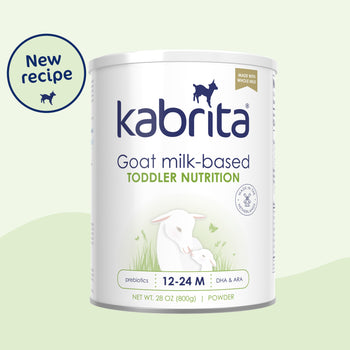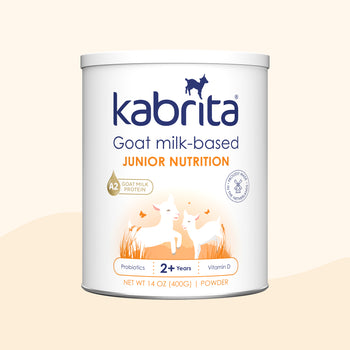-
Gentle proteins
-
Natural oligosaccharides
-
Whey-to-casein ratio
-
Premium fat blend
Proteins are key for a baby's growth and are the building blocks of their muscles, tissues, and organs.
Our formula includes whey and casein, the same proteins found in breast milk and similar to the 60:40 mix for a baby's needs.
It's also easy on babies' bellies. It forms smaller, softer curds when digested, compared to cow milk-based formula, making it easier for babies to digest.¹⁻²
Goat milk oligosaccharides, a special type of complex carbohydrate and prebiotic fiber, may help with tummy issues³⁻⁵
With goat milk having higher levels of these naturally-occurring oligosaccharides than cow milk, they also more closely resemble breast milk.⁶ Goat milk has five times more oligosaccharides than cow milk!⁷ Some of these oligosaccharides are exactly the same as in breast milk, helping to make our formula gentle for babies.
Whey is the portion of milk protein that remains liquid in the gut. Casein is the portion of milk protein that forms the curd during digestion.
That's why we add goat whey concentrate to Kabrita Goat Milk-Based Infant Formula. Doing this helps to adapt the whey to casein ratio of our product to 60:40, the ratio similarly found in breast milk, to support easier digestion.⁸⁻⁹
Beta-palmitate is a more absorbable form of palmitic acid, a major fatty acid found in breast milk. While it doesn't naturally occur in goat milk, we realized that adding it to Kabrita Goat Milk-Based Infant Formula could greatly benefit babies.
Beta-palmitate may lead to improved calcium absorption, fat absorption, and stool consistency - and these results are associated with improved bone health and gut health as well as reduced crying and improved sleep.¹⁰⁻¹²
Our formula includes high levels (>40%) of beta-palmitate, and we're proud to say that we're the only infant formula in the US that includes this premium ingredient.

Supported by the infant formula experts
The use of goat milk-based infant formula is supported by the American Academy of Pediatrics (AAP) as an acceptable source of nutrition for all infants in their first year of life.¹³
Trust our experience
Kabrita is powered by Ausnutria, a Dutch company with over 75 years of infant formula
experience, and the first choice in goat milk infant formula worldwide.
Contains all the important ingredients babies need:
- 25 vitamins and minerals, including folic acid, iron, and vitamin B12
- DHA and ARA, which are healthy fats necessary for developing brains and vision¹⁴⁻¹⁷
- Prebiotic GOS, which acts as good bacteria in the intestine, improves stool consistency, helps to prevent hard stools and constipation¹⁸⁻²¹
Scientifically and clinically proven to safely support growth for babies in a double-blind, randomized controlled trial.²²
Made in the Netherlands and adheres to strict European standards that limit the use of antibiotics, growth hormones, and pesticides. That means no GMO ingredients, corn syrup or glyphosate.
Made with 100% goat milk from the Netherlands, the dairy center of the world. All milk is supplied from over 100 Dutch family-run goat farms that comply with the Dutch Goat Dairy Organization animal welfare and food safety assurance program.
Already used and trusted by parents around the globe. In fact, 1.5 million babies worldwide are fed with Kabrita daily!
The first and only goat milk-based infant formula in the US to meet all FDA requirements. Other goat milk-based infant formulas are authorized under
short-term emergency use only.
Complete supply chain ownership
We own the entire product journey from grass to bottle, to ensure high quality and availability of the formula that arrives at your home

References:
1. Clark S, Mora García MB. A 100-Year Review: Advances in goat milk research. J Dairy Sci. 2017;100(12):10026-10044.
2. Jakobsson I, Lindberg T. Cow's milk proteins cause infantile colic in breast-fed infants: a double-blind crossover study. Pediatrics. 1983;71(2):268-271.
3. Leong A, et al. Oligosaccharides in goats’ milk-based infant formula and their prebiotic and anti-infection properties. Br J Nutr. 2019;122(4):441-449.
4. Oliveira DL, et al. In vitro evaluation of the fermentation properties and potential prebiotic activity of caprine cheese whey oligosaccharides in batch culture systems. Biofactors. 2012;38(6):440-9.
5. Lara-Villoslada F, et al. Oligosaccharides isolated from goat milk reduce intestinal inflammation in a rat model of dextran sodium sulfate-induced colitis. Clin Nutr. 2006;25(3):477-88.
6. van Leeuwen SS, Te Poele EM, Chatziioannou AC, Benjamins E, Haandrikman A, Dijkhuizen L. Goat milk oligosaccharides: their diversity, quantity, and functional properties in comparison to human milk oligosaccharides. J Agric Food Chem. 2020;68(47):13469-13485.
7. Martinez-Ferez A, et al. Goats’ milk as a natural source of lactose-derived oligosaccharides: Isolation by membrane technology. International Dairy Journal. 2006;16(2):173-181.
8. Nilsen H, Olsen HG, Hayes B, et al. Casein haplotypes and their association with milk production traits in Norwegian Red cattle. Genet Sel Evol. 2009;41(1):24.
9. Lönnerdal B. Bioactive Proteins in Human Milk: Health, Nutrition, and Implications for Infant Formulas. J Pediatr. 2016;173 Suppl:S4-S9.
10. Bronsky J, et al. Palm oil and beta-palmitate in infant formula: a position paper by the European Society for Paediatric Gastroenterology, Hepatology, and Nutrition (ESPGHAN) Committee on Nutrition. J Pediatr Gastroenterol Nutr. 2019;68(5):742-760.
11. Havlicekova Z, et al. Beta-palmitate - a natural component of human milk in supplemental milk formulas. Nutr J. 2016;15:28.
12. Miles EA, Calder PC. The influence of the position of palmitate in infant formula triacylglycerols on health outcomes. Nutr Res. 2017;44:1-8.
13. American Academy of Pediatrics. Lactose Intolerance in Infants & Children: Parent FAQs. Accessed August 30, 2023. https://www.healthychildren.org/English/ages-stages/baby/formula-feeding/Pages/choosing-an-infant-formula.aspx
14. Brenna JT. Arachidonic acid needed in infant formula when docosahexaenoic acid is present. Nutr Rev. 2016;74(5):329-336.
15. Lawrence RA, Lawrence RM. Breastfeeding: a guide for the medical profession. 2011: Elsevier Health Sciences.
16. McNamara RK, Able J, Jandacek R, et al. Docosahexaenoic acid supplementation increases prefrontal cortex activation during sustained attention in healthy boys: a placebo-controlled, dose-ranging, functional magnetic resonance imaging study. Am J Clin Nutr. 2010;91(4):1060-1067.
17. EFSA Panel on Dietetic Products, N.a.A.N. Scientific opinion on the substantiation of a health claim related to DHA and contribution to normal brain development pursuant to Article 14 of Regulation (EC) No 1924/20061. EFSA Journal. 2009;12(10).
18. Macfarlane GT, Steed H, Macfarlane S. Bacterial metabolism and health-related effects of galacto-oligosaccharides and other prebiotics. J Appl Microbiol. 2008;104(2):305-344.
19. Chen YL, Liao FH, Lin SH, Chien YW. A Prebiotic Formula Improves the Gastrointestinal Bacterial Flora in Toddlers. Gastroenterol Res Pract. 2016;2016:3504282.
20. Ribeiro TC, Costa-Ribeiro H Jr, Almeida PS, et al. Stool pattern changes in toddlers consuming a follow-on formula supplemented with polydextrose and galactooligosaccharides. J Pediatr Gastroenterol Nutr. 2012;54(2):288-290.
21. Vaisman N, Press J, Leibovitz E, Boehm G, Barak V. Short-term effect of prebiotics administration on stool characteristics and serum cytokines dynamics in very young children with acute diarrhea. Nutrients. 2010 Jul;2(7):683-92.
22. He T, Woudstra F, Panzer F, Haandrikman A, Verkade HJ, van Lee L. Goat milk based infant formula in newborns: A double-blind randomized controlled trial on growth and safety. J Pediatr Gastroenterol Nutr. 2022;75(2):215-220.





